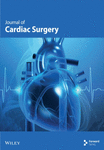Implantation of the Unstented Bioprosthetic Aortic Root: An Improved Method
Abstract
Abstract The problem of early onset aortic insufficiency as seen with the scalloped, sub-coronary homograft aortic valve replacement is reduced with the use of a total root replacement. In addition, the naturally competent aortic root is more durable. From September 1985 to April 1991, 26 consecutive patients underwent aortic root replacement with 10 autografts, 14 homografts, and 2 xenografts using a modified implantation method. Twenty-five patients were discharged from the hospital. This partial inclusion root technique for implanting unstented valves in the aortic position decreases the probability of early failure secondary to technical malalignment at the time of implantation. In contrast to total root replacement, it avoids the need to destroy the recipient aortic root. A longitudinal aortotomy is performed to the aortic annulus in the mid-portion of the noncoronary sinus. The proximal suture line is interrupted with the valve oriented in the anatomical position. Circumferential running monofilament side-to-side anastomoses approximate the donor coronary ostia to the recipient. A running medial and lateral posterior suture line to the lateral superior portions of the aortotomy completes the integrity of the anterior wall of the implantation. One autograft attempt failed and one homograft patient died postoperatively. Follow-up ranges from 1 to 6 years in 24 patients. Postoperative aortic insufficiency was significant in one case due to inappropriate sizing of the proximal aortic suture line. There has been no evidence of progressive aortic insufficiency detected by the early onset of diastolic murmurs or echocardiograms as was our previous experience with the scalloped subcoronary method.




